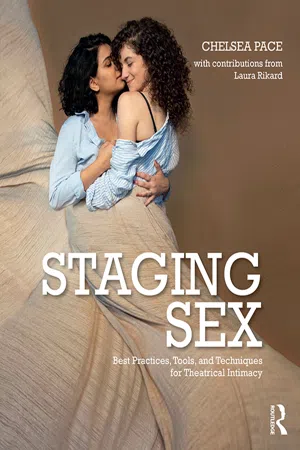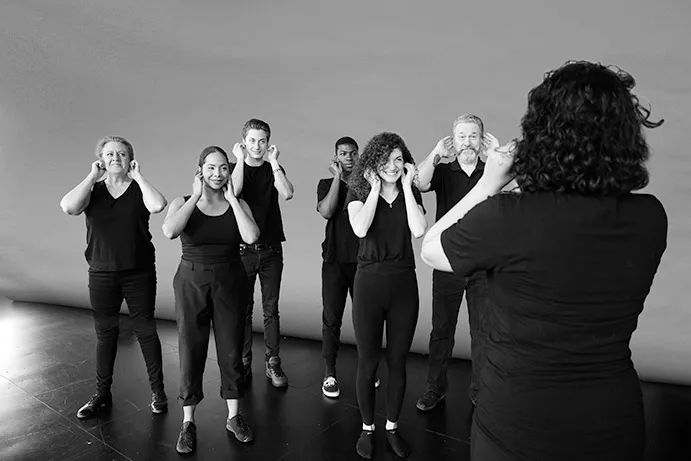Environmental Factors
For all of the tools and techniques to work effectively, a few rehearsal environment tweaks may be needed to set the tone for the process. Using the following phrases can contribute to a positive, consent-based working environment:
- Say, “Your boundaries are perfect exactly where they are.”
This helps normalize boundary setting. Performers have long been told that their boundaries are a hindrance, so this seemingly obvious statement goes a long way to make it clear that the actors have a right to their boundaries. This statement helps relieve a lot of actors’ worry about what they might be asked to do, and also reminds everyone to not take anyone else’s boundaries personally.
- Say, “It’s ok if your boundaries change. Check in on boundaries with your partner.”
Circumstances and context change the way touch is received. Only the boundary-holder can negotiate their boundaries, not anyone else. Directors unknowingly ask performers to ignore or change their boundaries all the time. Scene partners can be even worse offenders. Reminding everyone who controls the boundaries and enforcing that performer boundaries are the law of the rehearsal-land continues to establish performer autonomy.
When introducing the idea of a check-in, give examples of how checking-in can be a neutral, or even positive thing. Don’t assume the actors will casually let you know if things change. Checking in on boundaries, or someone’s comfort level, can be complicated if the process isn’t formalized. Actively normalizing boundary check-ins allows for performers to take responsibility for maintaining and updating their boundaries as the process progresses.
- Ask “May I touch you?” and “Would you like a hug?”
There is an assumption that all theatre people are touchy and interested in hugs. Start asking in rehearsal and in life.
- Ask “Does that work for you?” “What are your thoughts on that?” or “How do you feel about that?”
In school, you may have learned that asking open questions was the key to getting interesting answers. An open question is one that doesn’t have an implied, or expected answer. “Is that ok?” sets an expectation that the answer is “yes, that’s ok.” But the question, “How does that work for you?” doesn’t have a built-in answer. The answerer might realize they aren’t sure how something works for them. They take an extra second to orient themselves to your question and to consult their boundaries before they answer. That little bit of extra flexibility takes unintentional pressure off of the performer to say what they think you want to hear.
Open questions aren’t just for directors. In rehearsal, open questions between actors are key to understanding clear boundaries and to developing interesting choreography that works for everyone. If a scene partner says, “I’ll hug you at the end of my line,” there isn’t a lot of room for the other partner to consider their boundaries around a hug. “What do you think about a hug at the end of the line?” still suggests a hug, but leaves room for a counterproposal. Rather than having to reject the suggestion outright to preserve boundaries, or say “yes” to avoid rocking the boat, the actor can take a beat, consult their boundaries, and make a suggestion.
Instead of “can I touch your shoulder?” try “how would you feel about me touching your shoulder at this moment?” Replace “you okay with that?” with “what do you think?” Rather than “grab his face,” ask “what do you think comes next?”
Open questions create opportunities for everyone to consider what is being asked of them and to make suggestions that work for their boundaries.
- Say: “Let’s get you some support.”
Rehearsal processes can be intense. Particularly if you are working with potentially triggering material, actors may need support beyond what the production can, or should, provide. If a member of the production is in crisis, don’t tell them to “use it” in the scene and resist any urge to play therapist. It can be traumatizing to the person in crisis, traumatizing to the other people in the room, and it crosses professional boundaries when unqualified people try and take responsibility for the mental health of others.
If things get emotional in rehearsal, remember that while theatre may be therapeutic, it’s not therapy. Maintaining good boundaries, supporting good technique, and enlisting the appropriate resources are all you can to do to take care of your ensemble mentally and emotionally in rehearsal. Assemble a resource page and include it in the handouts at the first rehearsal. Include hot line and resource center numbers. Check for community centers that might provide counselling at low or no cost. If you are on a campus, add information about university counselling services. Have a crisis plan and know how to reach professionals.
Taking on an emotional support role as a director blurs the line for the ensemble about your role in the process. If a member of the ensemble needs emotional support, be compassionate and refer them to a professional.
The Boundary Tools
There are three tools for establishing boundaries in rehearsal:
Those tools come together in an exercise called The Boundary Practice. The Boundary Practice is an exercise designed to address the complex problems of unclear expectations and general awkwardness around negotiating consensual touch. Many directors have developed versions of some of these tools to begin to address the complexities of establishing boundaries, but it is this comprehensive combination of tools makes The Boundary Practice effective.
Please note: The Boundary Practice has two major components: a physical exercise and a verbal reinforcement. It is critical that the physical exercise precedes the verbal. Verbal boundary establishment may seem quicker, but when used alone it leaves more room for common scripts and expectations to take hold. “You can touch me anywhere,” is something an “easy to work with” actor might say, or feel pressured to say. “You can touch me anywhere,” pressures their partner to say, “yeah, me too.” “Is that ok?” is an often uttered phrase by conscientious educators and respectful partners, but it has an implied, or expected answer: “yes.” Ask as room of people where their upper thigh begins and you will get as many answers as there are people in the room. The issue with verbal boundaries is that they are more susceptible to generalization and social pressure than physically established ones.
To understand the complete Boundary Practice, let’s first look at the individual tools.
Button
The Button is a word that indicates that the action needs to pause for a moment. Pauses might be to ask a question, clear something up, shake something out, or even to avoid sneezing into someone’s face. Calling “hold” or “stop” or even “wait” can feel like too much of a fuss if someone just needs a moment.
Introduce The Button to your whole ensemble early and remind them of it often, preferably before any staging begins. Giving them space to pause and ask questions gives them more opportunities to say “yes.”
Choosing a Button Word
The Button word should be a word that is easy for the ensemble to remember. It can be fun to let each cast or class choose a Button, but that can lead actors to fumbling to remember which word is the right word in a heightened moment. “Button” is easy to remember (it’s the “Pause Button”) and it’s easy to say.
If you decide to use a different word, there are two rules when choosing a Button word:
- The Button word exists outside of the world of the play. It shouldn’t appear in the script and should be a word unlikely to come up in rehearsal. Even if the characters never say “computer,” if there is a computer on the set, find a word other than “computer” to be your Button.
- The Button word needs to be neutral. That means:
- The Button can’t have another meaning like “fire” or “help”
- The Button isn’t a word that substitutes “stop” in other contexts. That defeats the purpose of making it easier to say. Stay away from “pause” and “wait.”
Effective Button words include:
- Button
- Camp
- Racecar
- Canada
- Tofu
- Rodeo
- Polar Bear
- California
- Tangerine
The Button is an effective tool that helps the process along on several fronts. The first is that it keeps the actors from becoming self-indulgent. Rather than spending precious time explaining why they need a break, an actor can say the Button, shake it out, and get back to work. The second is that it helps with boundary maintenance. Say the Button, ask your partner for permission or clarification, and continue right where you left off. Button is calling line on boundaries. Third, the Button helps prevent actors from emotionally hijacking a rehearsal room. Let them know that you will be choosing a Button for the process and that they should call Button any time they need to pause the process. Every time Button is called, the actor then must say what they need. Some examples:
- Button. Where does my hand go?
- Button. I need a minute to shake it out.
- Button. Can you remind me how long the kiss should be?
This tool is effective because it gives the actors a chance to breathe and something to say when their Fight-Flight-Freeze response takes over. Even in a positive and relaxed rehearsal environment, emotions can be heightened. If an actor has been fully engaged with a high-stakes scene, a simple logistical question might send them into survival mode. The Button gives everyone a way to work through that moment of panic.
In rehearsal, the actors remain in the moment, as they do when calling for “line,” and then they can ask whatever question they need to ask, breathe for a second, or remind their partner of a boundary. Once they have what they need, the work continues. Functionally, the Button is a mini-hold or a “yellow-light” safeword. But hold is used to indicate physical safety or danger and the term “safeword” has real-life sexual implications, so both are to be avoided for general actor concerns. The Button normalizes needing to pause for a second and ask a question or adjust a boundary. Performers need that permission, and having a tool in place to support them will help your process and give them an established way to ask for what they need.
Games for Practicing “No” and Button
Two games, both variations on classics, can help the room get familiar with saying “Button.”
Simon Says (with Some Twists)
One player is Simon. Simon gives instructions. If the instruction is prefaced by “Simon Says” the players should follow it, and without the preface, they do not. Play a few rounds with the standard rules before you add the first twist: the participants at any time, for any reason, can choose not to comply with Simon’s command, even if Simon “said.” Instead, the participants return to neutral and say “no.” The “no’s” might be timid at first, or Simon might need to be tyrannical (ask the participants to pick their noses or their teeth) to get a “no” from your group. Or they might be a group that loves shouting “NO” right off the bat.
After playing a few rounds with the “no” option, ask the participants how it felt to say “no” to the person in charge. They may say it felt uncomfortable at first. Or that it made them feel powerful. Some might observe that after they say “no,” nothing bad happened, which is, of course, the whole point. When “no” is the only alternative to “yes,” it can feel risky to say.
As Simon, hearing even a tentative “no” can feel a lot like hearing “NO!” is being shouted at you. It can feel like your authority is being challenged, and not in a good ...

